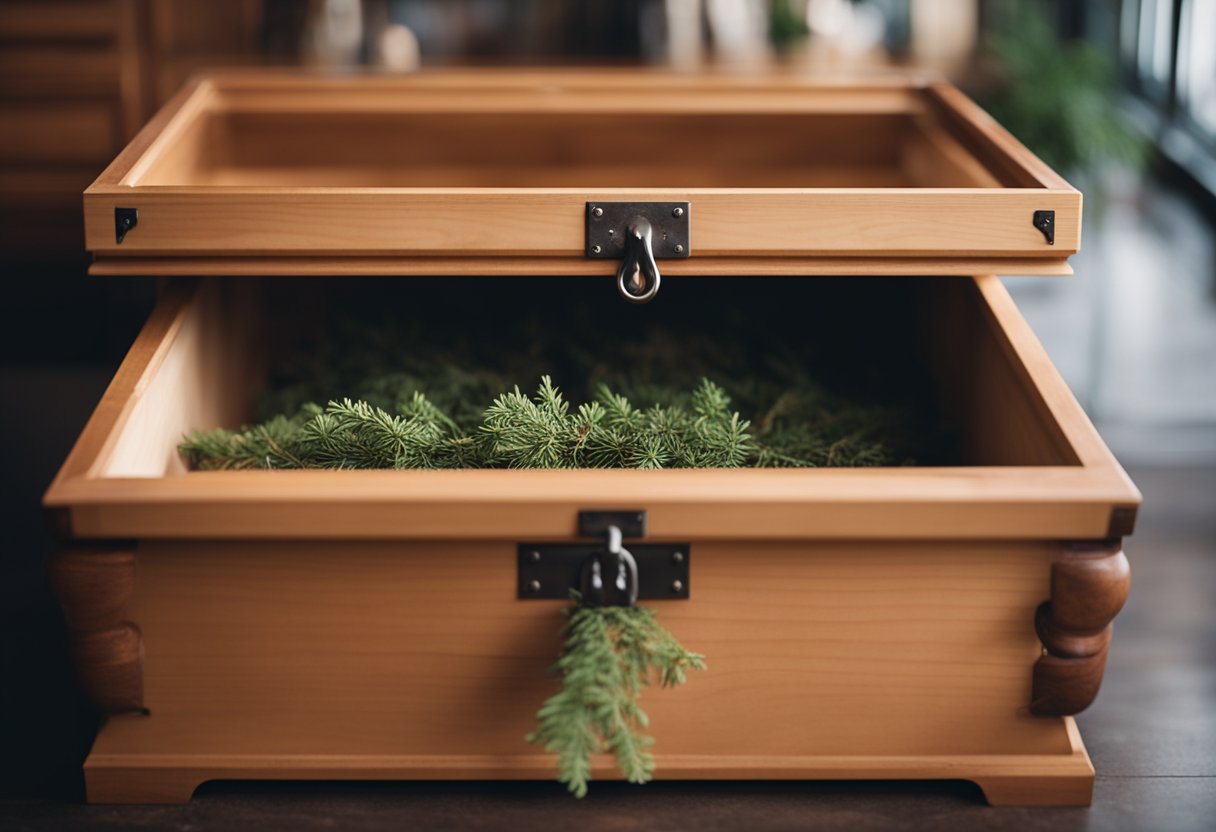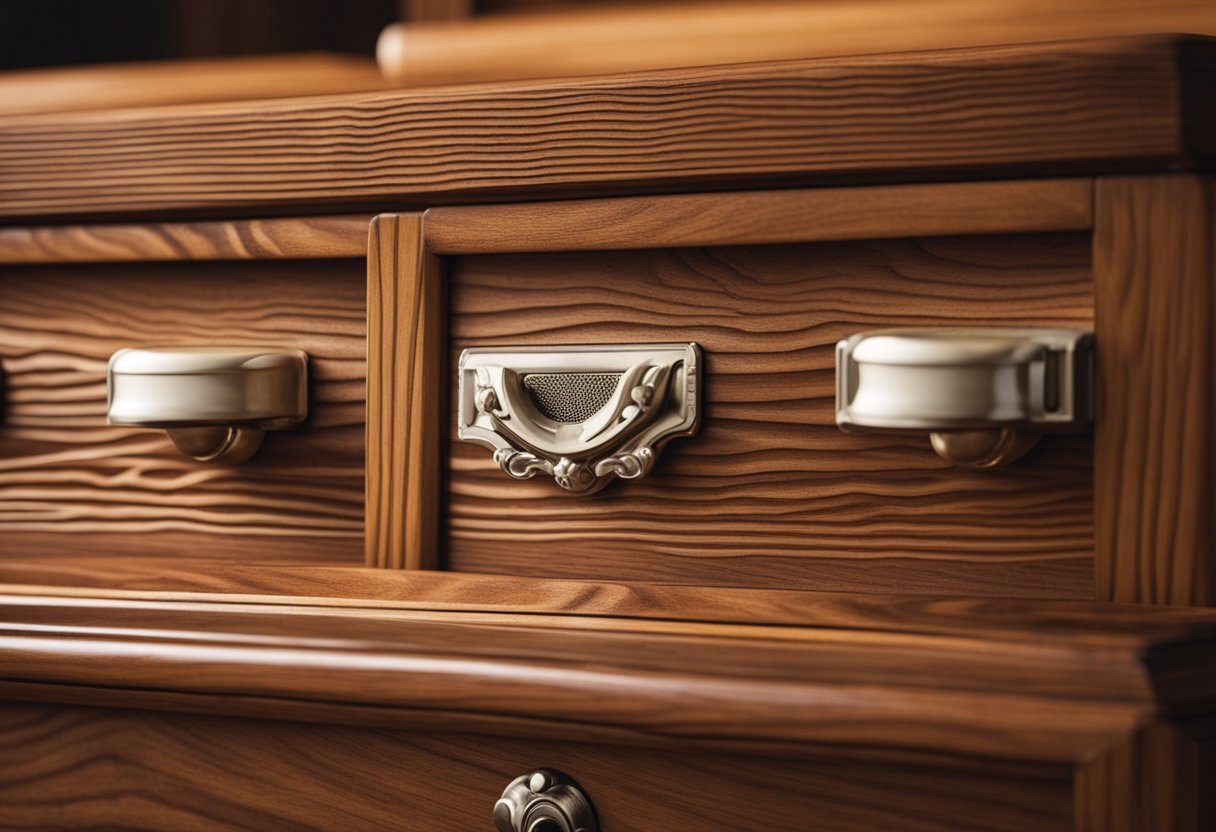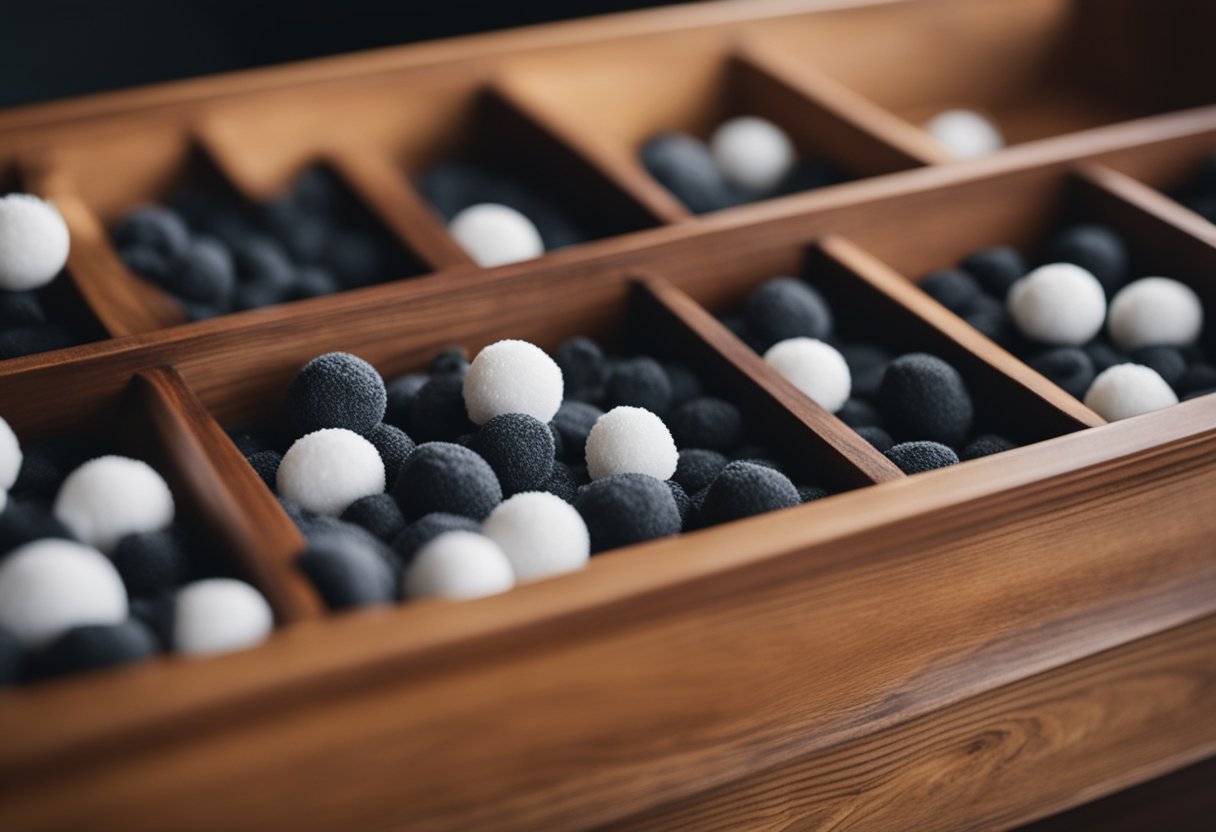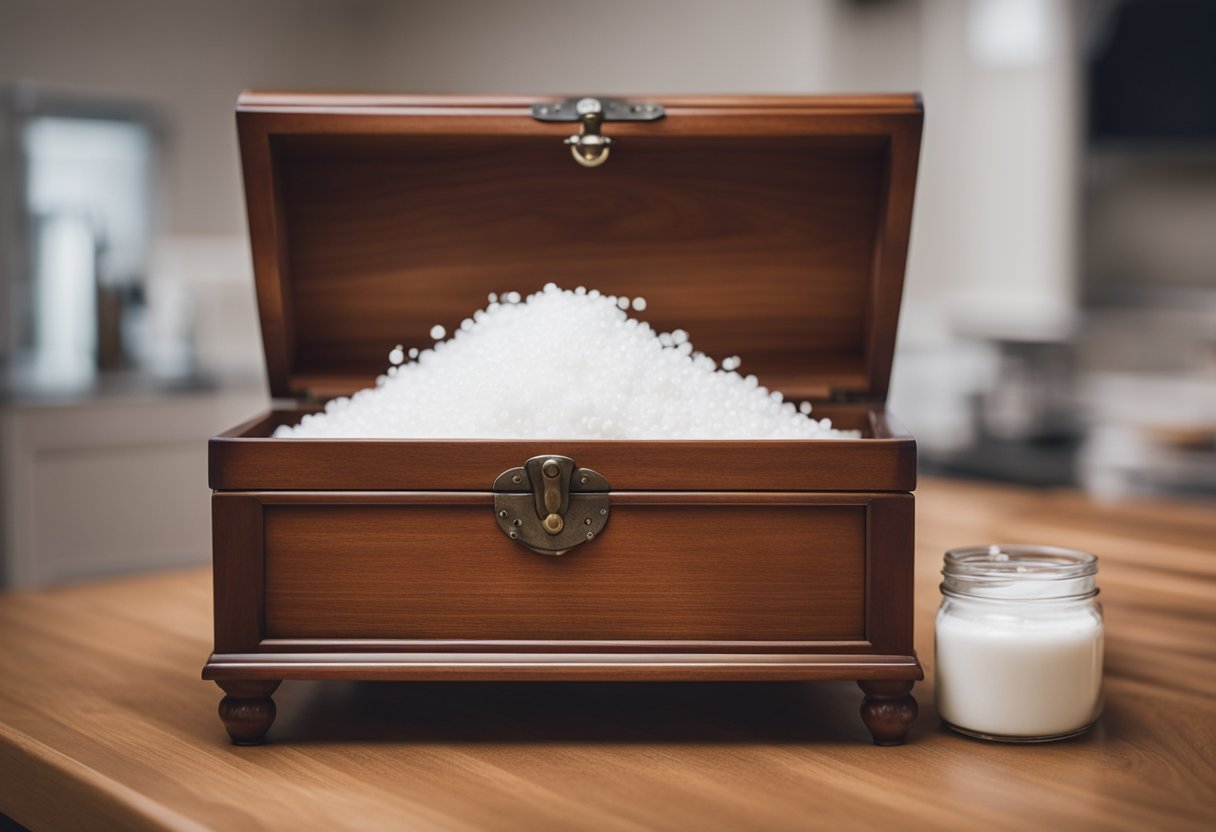Getting mothball smell out of a cedar chest can be a challenging task. Cedar chests are popular for their ability to repel moths and other insects, but they tend to absorb the strong odor of mothballs. This can be a problem, especially if you plan to use the chest to store clothes or other items that you don’t want to smell like mothballs. Fortunately, there are several effective ways to get rid of the mothball smell and restore the fresh, natural scent of cedar.

Understanding the Mothball Smell is essential to know how to remove it. Mothballs are made of a chemical called naphthalene, which gives off a strong, pungent odor that can be difficult to eliminate. The smell can penetrate deep into the wood fibers of the cedar chest, making it challenging to remove. However, with the right techniques and materials, you can get rid of the odor and enjoy the natural scent of cedar.
Why Cedar Chests Attract Mothball Odor is because cedar wood is porous and can absorb odors easily. When mothballs are placed inside a cedar chest, the naphthalene chemical can easily seep into the wood fibers and stay there for a long time. This is why it’s essential to take preventive measures to avoid mothball odor in the first place. If you already have the smell in your cedar chest, don’t worry. There are several ways to get rid of it.
Key Takeaways
- Cedar chests tend to absorb the strong odor of mothballs, making it challenging to remove.
- Mothballs are made of naphthalene, which gives off a strong, pungent odor that can penetrate deep into the wood fibers of the cedar chest.
- Preventive measures can help avoid mothball odor, and there are several effective ways to get rid of it if you already have it.
Understanding the Mothball Smell

As someone who has dealt with the unpleasant smell of mothballs in a cedar chest before, I understand how frustrating it can be. The mothball smell is caused by the chemicals naphthalene or paradichlorobenzene, which are commonly used as insect repellents. These chemicals are toxic and can pose a health risk if inhaled in large quantities.
When stored in a cedar chest, the strong odor of mothballs can permeate the wood and make it difficult to remove. It’s important to note that the smell of mothballs is not just unpleasant, but also potentially harmful to your health. It’s essential to take the necessary precautions when dealing with mothballs and their odor.
One of the first steps in removing the mothball smell from a cedar chest is to identify the type of mothballs used. If they contain naphthalene, it’s important to note that this chemical is more toxic than paradichlorobenzene and requires more care when handling. It’s also important to note that the odor of mothballs can linger for a long time, even after the mothballs themselves have been removed.
To effectively remove the mothball smell from a cedar chest, it’s essential to use the right techniques and materials. Some common methods include airing out the chest, using activated charcoal or baking soda, and sanding the wood. It’s important to follow these methods carefully and not use any harmful chemicals that could damage the wood or pose a health risk.
In summary, understanding the mothball smell is crucial when dealing with a cedar chest that has been stored with mothballs. It’s important to take the necessary precautions when handling these chemicals and to use safe and effective methods to remove the odor. With the right techniques and materials, it is possible to remove the mothball smell and restore your cedar chest to its original state.
Why Cedar Chests Attract Mothball Odor

As an expert in woodworking, I have encountered many clients who have complained about the mothball odor in their cedar chests. Cedar chests are known for their pleasant aroma, but they can also attract mothball odor. In this section, I will explain why cedar chests attract mothball odor and what you can do to get rid of it.
Cedar wood contains natural oils that give it its characteristic aroma. These oils also make cedar wood resistant to pests, such as moths. However, when cedar wood is exposed to mothballs, the oils in the wood absorb the chemicals from the mothballs, causing the wood to emit a strong odor. This is why cedar chests can attract mothball odor even if mothballs were never stored in the chest.
Mothball odor can also be a sign of an infestation. If you notice a strong mothball odor in your cedar chest, it is possible that there are moths or other pests living in the chest. Moths are attracted to wool, fur, and other natural fibers, so if you store these items in your cedar chest, you may be providing a breeding ground for moths.
To prevent mothball odor and infestations, it is important to store your cedar chest properly. Keep it in a dry, cool place, away from direct sunlight. Avoid storing wool, fur, and other natural fibers in the chest. If you must store these items in the chest, make sure they are clean and free of any moth larvae or eggs. You can also line the chest with a natural pest repellent, such as lavender or cedar chips.
In the next section, I will discuss some effective methods for removing mothball odor from your cedar chest.
Initial Cleaning Techniques
When it comes to getting rid of mothball odor from a cedar chest, the first step is to clean the interior of the chest thoroughly. There are a few initial cleaning techniques that can be used to achieve this.
Vacuuming and Wiping
The first technique is to vacuum the interior of the chest. A vacuum cleaner with a hose attachment can be used to suck up any loose debris, dust, or mothball residue. Be sure to use a gentle suction setting to avoid damaging the wood. After vacuuming, use a microfiber cloth to wipe down the interior of the chest. This will help to remove any remaining dust or debris.
Using Detergent
Another technique is to use a mild detergent to clean the interior of the chest. Mix a small amount of detergent with warm water and use a soft cloth to apply the solution to the interior of the chest. Be sure to wring out the cloth thoroughly to avoid saturating the wood with water. After applying the solution, use a clean, damp cloth to wipe away any excess detergent. Finally, use a dry cloth to wipe the interior of the chest and allow it to air dry completely.
It is important to note that excessive abrasion, harsh chemicals, or water can damage the wood of the cedar chest. Therefore, it is important to use gentle cleaning techniques and avoid saturating the wood with water.
Natural Odor Absorbers

As someone who has dealt with the unpleasant smell of mothballs in a cedar chest, I know how frustrating it can be to get rid of the odor. Fortunately, there are natural odor absorbers that can help eliminate the mothball smell from your cedar chest. Here are a few methods to try:
Baking Soda Method
Baking soda is a great natural odor absorber that can help remove the mothball smell from your cedar chest. Simply sprinkle a generous amount of baking soda inside the chest and let it sit for a few days. After a few days, vacuum up the baking soda and wipe the chest with a damp cloth. Repeat the process if necessary.
Coffee Grounds Technique
Coffee grounds are another great natural odor absorber that can help remove the mothball smell from your cedar chest. Place a few cups of coffee grounds inside the chest and let them sit for a few days. After a few days, remove the coffee grounds and wipe the chest with a damp cloth.
Activated Charcoal Approach
Activated charcoal is a highly effective natural odor absorber that can help remove even the strongest odors, including mothball smell from your cedar chest. Simply place a few pieces of activated charcoal inside the chest and let them sit for a few days. After a few days, remove the charcoal and wipe the chest with a damp cloth.
Cat Litter Solution
Cat litter is another natural odor absorber that can help remove the mothball smell from your cedar chest. Place a few cups of cat litter inside the chest and let them sit for a few days. After a few days, remove the cat litter and wipe the chest with a damp cloth.
Using dry odor absorbers like baking soda, coffee grounds, activated charcoal, and cat litter can help eliminate the mothball smell from your cedar chest. These natural odor absorbers are safe, effective, and easy to use. Give them a try and enjoy a fresh-smelling cedar chest once again!
Using Vinegar to Remove Mothball Smell
If you have a cedar chest that smells like mothballs, vinegar is a great solution to get rid of the smell. Here are two simple methods to use white vinegar or lemon juice to remove the mothball odor from your cedar chest.
White Vinegar Technique
White vinegar can help neutralize the smell of mothballs. Here’s how to use it:
- Mix equal parts of white vinegar and water in a spray bottle.
- Spray the solution inside the cedar chest and on any other surfaces.
- Let the solution sit for 30 minutes.
- Wipe the surfaces with a clean, damp cloth to remove any excess vinegar.
- Allow the chest to air dry completely before closing it.
Lemon Juice Method
Lemon juice is another natural solution that can help remove the mothball smell from your cedar chest. Here’s how to use it:
- Squeeze fresh lemon juice into a spray bottle.
- Spray the solution inside the cedar chest and on any other surfaces.
- Let the solution sit for 30 minutes.
- Wipe the surfaces with a clean, damp cloth to remove any excess lemon juice.
- Allow the chest to air dry completely before closing it.
Both of these methods are effective and safe to use on cedar wood. However, it is always a good idea to test the solution on a small, inconspicuous area before applying it to the entire chest.
Using vinegar or lemon juice is an easy and affordable way to remove the mothball smell from your cedar chest.
Additional Techniques for Odor Removal

If the mothball smell in your cedar chest persists, there are a few more techniques you can try to remove the odor.
Heat and Air Method
One effective way to get rid of the mothball smell is to use heat and air. You can do this by placing the cedar chest in a well-ventilated area and using a fan to circulate the air. Then, use a hairdryer or heat gun to blow hot air into the chest. Be sure to keep the heat source moving, so you don’t scorch the wood. The heat will help to evaporate the mothball odor, while the fresh air will help to disperse it.
Newspaper and Sun Technique
Another method to try is the newspaper and sun technique. First, wrap the cedar chest in several layers of newspaper. Then, place it in direct sunlight for several hours. The sun’s heat will help to evaporate the mothball odor, while the newspaper will absorb it. Be sure to rotate the chest periodically, so all sides get exposed to the sun.
Remember, the key to getting rid of the mothball smell is to be patient and persistent. It may take several attempts before you notice a significant improvement. In the meantime, keep the chest in a well-ventilated area and try to air it out as much as possible.
Refinishing the Cedar Chest
If the mothball odor in your cedar chest is persistent, you may need to refinish the chest to get rid of the smell. Refinishing will not only eliminate the odor but also restore the chest’s natural beauty.
Sanding the Chest
The first step in refinishing a cedar chest is sanding. Sanding helps to remove the old finish, scratches, and dents on the chest’s surface. It also opens up the pores in the wood, which helps to absorb the new finish and the cedar aroma.
To sand the chest, you will need to use fine-grit sandpaper. Start by sanding the chest’s exterior, then work on the interior. Sand with the grain of the wood to avoid damaging the wood fibers. Be gentle and don’t apply too much pressure as it can create uneven surfaces.
After sanding, use a vacuum cleaner to remove the dust from the chest’s surface. You can also use a tack cloth to wipe away any remaining dust particles.
Refinishing
Once you have sanded the chest, it’s time to apply the new finish. You can use wood oil, varnish, or lacquer to refinish the chest. These finishes will not only protect the wood but also enhance its natural beauty and aroma.
Before applying the new finish, make sure the chest is clean and dry. Apply the finish with a brush or a cloth, following the manufacturer’s instructions. Apply thin coats to avoid drips and runs.
After applying the finish, let it dry for at least 24 hours before using the chest. The new finish will restore the chest’s natural beauty and aroma, and eliminate the mothball odor.
Refinishing a cedar chest can be a daunting task, but it’s worth the effort. It will not only get rid of the mothball odor but also restore the chest’s natural beauty and aroma. With proper sanding and refinishing, your cedar chest will look and smell like new again.
Preventive Measures and Precautions

Storing Clothes Properly
As someone who has dealt with the unpleasant smell of mothballs in a cedar chest, I know how important it is to store clothes properly to prevent moth infestations. Moths are attracted to dark, undisturbed areas, so it’s important to store clothes in well-lit areas. Additionally, it’s important to store clothes in sealed containers to prevent moths from getting in. I recommend using airtight containers made from plastic, metal, or glass to store clothes.
Using Natural Repellents
There are many natural repellents that can help prevent moth infestations and eliminate mothball smells. Cedar chips are a popular choice and can be placed in drawers or hung in closets to repel moths. Other natural repellents include rosemary, herbs, essential oils, sachets, cinnamon sticks, eucalyptus leaves, peppercorns, and wormwood. These natural repellents can be placed in sachets or tied in cheesecloth and placed in drawers or closets to repel moths.
It’s important to note that natural repellents may not be as effective as chemical repellents, but they are a safer alternative. Additionally, natural repellents may need to be replaced or refreshed periodically to remain effective.
In conclusion, taking preventive measures and using natural repellents can help prevent moth infestations and eliminate mothball smells in cedar chests. By storing clothes properly and using natural repellents, you can keep your clothes and cedar chest smelling fresh and clean.
Health and Safety Considerations

As with any cleaning task, there are a few health and safety considerations to keep in mind when removing mothball odor from a cedar chest. Here are some tips to ensure that the process is safe for you, your family, and your pets:
-
Toxicity: Mothballs contain chemicals that can be harmful if ingested or inhaled. Therefore, it is important to wear gloves and a mask when handling mothballs or cleaning up mothball residue.
-
Children and Pets: Keep children and pets away from the cleaning area while you are removing the mothball odor. Store the chest in a safe location where children and pets cannot access it until the odor is completely gone.
-
Moisture, Mold, and Mildew: Cedar chests are prone to moisture buildup, which can lead to mold and mildew growth. To prevent this, make sure that the chest is completely dry before storing any items inside.
-
Dampness: Dampness can exacerbate the mothball odor, so it is important to keep the chest in a dry location. Avoid storing the chest in a damp basement or attic.
-
Residue: Mothball residue can be difficult to remove, so it is important to use the right cleaning products and techniques. Avoid using harsh chemicals that can damage the cedar wood or leave behind a toxic residue.
By following these health and safety considerations, you can safely and effectively remove mothball odor from your cedar chest.
Frequently Asked Questions
How can I remove the strong odor from a cedar chest?
If you have a cedar chest with a strong mothball odor, there are several methods you can use to remove the smell. One option is to lightly sand the wood inside the chest with a fine-grade sandpaper, which will release a fresh cedar smell. Then vacuum up the wood residue, and wipe with a microfiber cloth to get rid of the dust. Another option is to use a mixture of vinegar or lemon juice and water. Soak a cloth in the solution, rub the chest gently, and keep the lid open to let the chest dry. You can also pour the solution into a sprayer and spray the solution on the chest surfaces.
What are some effective ways to eliminate mothball smell from fabric?
If you have mothball odor on your clothes, you can try washing them in hot water with detergent and a cup of white vinegar. You can also use baking soda to absorb the odor. Sprinkle baking soda on the clothes and let it sit for a few hours before washing them. Another option is to use activated charcoal, which can help absorb the odor. Place the activated charcoal in a container with the clothes and let it sit for a few days.
Is it possible to get rid of mothball smell from shoes?
Yes, it is possible to get rid of mothball odor from shoes. One option is to place the shoes in a sealed plastic bag with a few dryer sheets for a few days. The dryer sheets will absorb the odor. You can also try placing the shoes in a container with activated charcoal or baking soda. Let the shoes sit for a few days to absorb the odor.
Will Febreze help in removing mothball odor from clothes?
Febreze can help mask the mothball odor on clothes, but it will not remove it completely. It is better to use other methods like washing the clothes with vinegar or baking soda to remove the odor.
What are some ways to neutralize mothball smell in wood?
To neutralize mothball odor in wood, you can use a mixture of vinegar or lemon juice and water. Soak a cloth in the solution, rub the wood gently, and keep the lid open to let the wood dry. You can also place a container with activated charcoal or baking soda in the wood to absorb the odor.
How can I restore the natural smell of cedar in a chest?
To restore the natural smell of cedar in a chest, you can lightly sand the wood inside the chest with a fine-grade sandpaper. This will release a fresh cedar smell. Then vacuum up the wood residue, and wipe with a microfiber cloth to get rid of the dust. You can also use cedar oil or cedar balls to refresh the smell of the chest.

Hi, I’m Sal Muller of Tooltrip.com. My DIY experience led me to understand essential power tools for home projects. Tooltrip.com guides enthusiasts and professionals in choosing right tools for any job. I provide concise top tool reviews for easier, efficient DIY.

